or "Roll-Your-Own" Network Attached Storage Device
Posted on October 4, 2003
Building the Disk Array
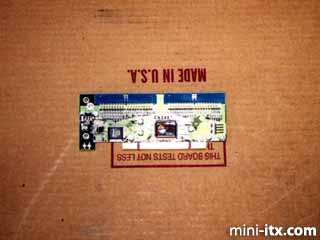
The first step in assembling the hardware for the disk array is to do a bit of disassembling. Removal of the PC slot cover is easily done by removing two screws and nuts. The next few steps are very time consuming. Using a 15W soldering iron to prevent damage to other components on the controller, we carefully remove the two blue IDE connectors.
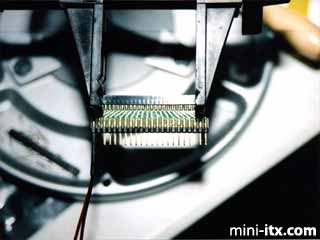
Now take two 44-pin to 40-pin laptop hard drive adapters and desolder the 40-pin male connectors. Also desolder the power wires.
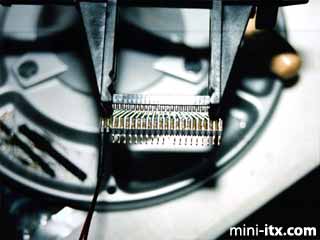
Next solder on the 40-pin right-angle connectors and heat the IDE key pin and remove it with a pair of needle nose pliers. Resolder the power wires directly to the PCB.
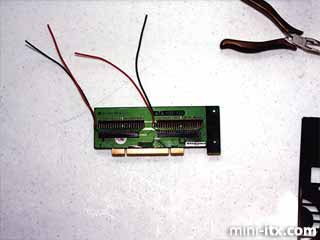
Soldering the 44-pin to 40-pin adapters to the back of the SIIG controller PCB takes a great deal of patience. You may have to take a few breaks while doing this step.
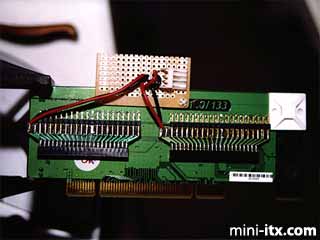
Now things get back to being easy. First we add a cable-tie mounting base to the back of the controller. This is to prevent the PCB from touching and grounding out on the Ethernet/USB connector shield when the controller is connected to the motherboard via a right-angle PCI riser. Second, a small section of a Radio Shack PCB (RSPCB), the Multipurpose PC Board (Catalog # 276-150), is added by drilling holes in the controller PCB. The RSPCB is attached with plastic expander pins. To complete this step, solder a male floppy drive power connector to the RSPCB then the power power wires from the 44-pin to 40-pin adapters.
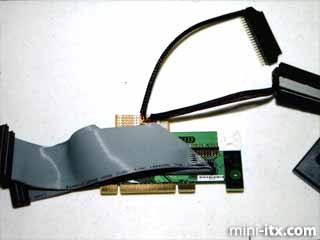
To complete the array controller, solder power wires for two 44-pin to 40-pin laptop hard drive adapters to the RSPCB. These will be used to connect power to the hard drives that will be connected to the motherboard IDE connectors. Note that one of the connectors has a 40-pin female to 40-pin female gender changer attached; this is for the secondary IDE channel on the motherboard. The other connector is for the hard drive that will be attached to the top of the power supply.
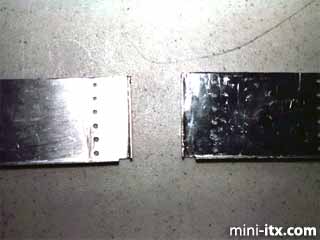
Two aluminum rackmount brackets provide the material for the mounting brackets for the hard drives. In the space above the power supply only 6 hard drives can fit due to the width of the Snap Server case. A quick run with the Dremel cuts the aluminum to the right height.
 |
 |
 |
Quick Links
Mailing Lists:
Mini-ITX Store
Projects:
Show Random
Accordion-ITX
Aircraft Carrier
Ambulator 1
AMD Case
Ammo Box
Ammo Tux
AmmoLAN
amPC
Animal SNES
Atari 800 ITX
Attache Server
Aunt Hagar's Mini-ITX
Bantam PC
BBC ITX B
Bender PC
Biscuit Tin PC
Blue Plate
BlueBox
BMW PC
Borg Appliance
Briefcase PC
Bubbacomp
C1541 Disk Drive
C64 @ 933MHz
CardboardCube
CAUV 2008
CBM ITX-64
Coelacanth-PC
Cool Cube
Deco Box
Devilcat
DOS Head Unit
Dreamcast PC
E.T.PC
Eden VAX
EdenStation IPX
Encyclomedia
Falcon-ITX
Florian
Frame
FS-RouterSwitch
G4 Cube PC
GasCan PC
Gingerbread
Gramaphone-ITX-HD
GTA-PC
Guitar PC
Guitar Workstation
Gumball PC
Hirschmann
HTPC
HTPC2
Humidor 64
Humidor CL
Humidor II
Humidor M
Humidor PC
Humidor V
I.C.E. Unit
i64XBOX
i-EPIA
iGrill
ITX Helmet
ITX TV
ITX-Laptop
Jeannie
Jukebox ITX
KiSA 444
K'nex ITX
Leela PC
Lego 0933 PC
Legobox
Log Cabin PC
Lunchbox PC
Mac-ITX
Manga Doll
Mantle Radio
Mediabox
Mega-ITX
Micro TV
Mini Falcon
Mini Mesh Box
Mini-Cluster
Mobile-BlackBox
Moo Cow Moo
Mr OMNI
NAS4Free
NESPC
OpenELEC
Osh Kosh
Pet ITX
Pictureframe PC
Playstation 2 PC
Playstation PC
Project NFF
PSU PC
Quiet Cubid
R2D2PC
Racing The Light
RadioSphere
Restomod TV
Robotica 2003
Rundfunker
SaturnPC
S-CUBE
SEGA-ITX
SpaceCase
SpacePanel
Spartan Bluebird
Spider Case
Supra-Server
Teddybear
Telefunken 2003
TERA-ITX
The Clock
ToAsTOr
Tortoise Beetle
Tux Server
Underwood No.5
Waffle Iron PC
Windows XP Box
Wraith SE/30
XBMC-ION
